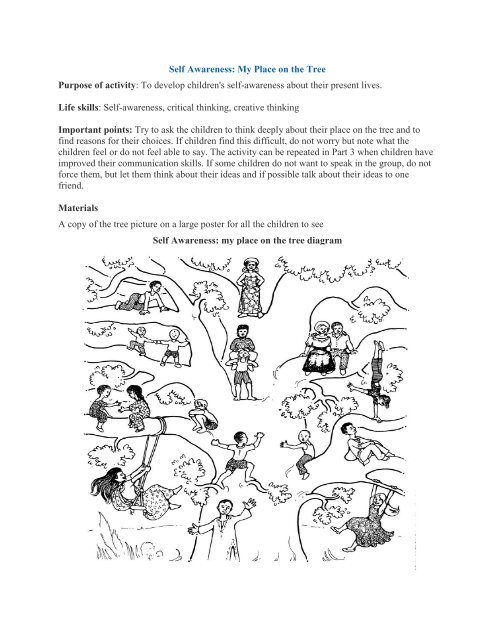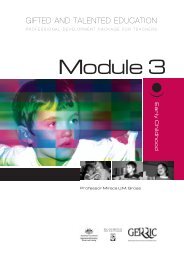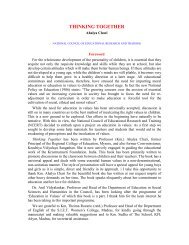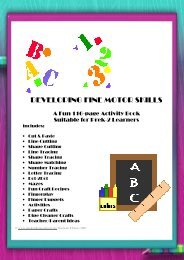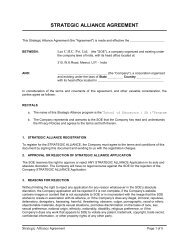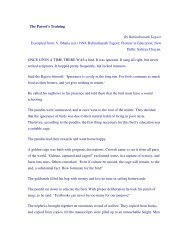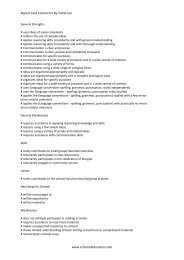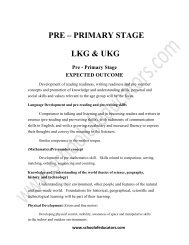Life Skills Activities for Students - School of Educators
Life Skills Activities for Students - School of Educators
Life Skills Activities for Students - School of Educators
- No tags were found...
Create successful ePaper yourself
Turn your PDF publications into a flip-book with our unique Google optimized e-Paper software.
Self Awareness: My Place on the TreePurpose <strong>of</strong> activity: To develop children's self-awareness about their present lives.<strong>Life</strong> skills: Self-awareness, critical thinking, creative thinkingImportant points: Try to ask the children to think deeply about their place on the tree and t<strong>of</strong>ind reasons <strong>for</strong> their choices. If children find this difficult, do not worry but note what thechildren feel or do not feel able to say. The activity can be repeated in Part 3 when children haveimproved their communication skills. If some children do not want to speak in the group, do not<strong>for</strong>ce them, but let them think about their ideas and if possible talk about their ideas to onefriend.MaterialsA copy <strong>of</strong> the tree picture on a large poster <strong>for</strong> all the children to seeSelf Awareness: my place on the tree diagram
Steps1. Show the children the picture and explain that the tree represents life. The people on the treeare at different stages <strong>of</strong> their lives. They are doing different things <strong>for</strong> different reasons.2. Ask the children to think <strong>of</strong> a well-known character in your country, <strong>for</strong> example a famoussports star, a character from a folktale or a famous person. Perhaps this person feels like theperson at the top <strong>of</strong> the tree because he looks sure <strong>of</strong> himself and powerful. She is smiling ateveryone below her. She is pleased with her position! Ask the children which figure in thepicture is like the famous person. (The children will probably have different ideas and differentreasons – that's fine).3. Show the children the figure(s) on the tree which show where you feel you are in life today.Explain the reasons <strong>for</strong> your choice.For example: I feel I am like the person doing a handstand halfway up the tree with one hand <strong>of</strong>fthe branch. I feel like this because I am feeling full <strong>of</strong> energy and I feel I am doing something abit different today by starting this life skills work with you. I am not sure if it will be fun or a bitrisky!4. Ask the children to choose one figure that is closest to themselves.5. In pairs or small groups, children discuss why they identified with a particular figure. Forexample…I feel like I am at the bottom <strong>of</strong> the tree waving and looking happy because I am just beginningthe life skills (so I am at the bottom <strong>of</strong> the tree). I am looking happy because I hope the class willhelp me and I am waving at my friends who will be with me.Final discussion:Do we feel like different people on the tree at different times <strong>of</strong> the day or week? Were youhappy to tell us about your figure? Why/Why not?Communication: NegotiationPurpose <strong>of</strong> activity: To identify negotiating skills and methods to bring about a change.<strong>Life</strong> skills: Communication & interpersonal relationships, self-awareness, critical thinking.Important points: Negotiations are more difficult when you are talking with someone withmore power. They can use that power to threaten or silence you or to ignore you. It can be usefulto look <strong>for</strong> go- betweens (an uncle, an older friend etc) who have similar power.MaterialsA chart showing symbols <strong>for</strong> the six steps in negotiationCommunication: Negotiation diagram
Steps1. Explain that negotiation involves putting yourself in the place <strong>of</strong> the other person andunderstanding their point <strong>of</strong> view. This is good <strong>for</strong> several reasons:It means you appreciate and respect the other person’s point <strong>of</strong> view. This reduces therisk that you will say something that causes conflict and hurt.If you recognise the other person’s point <strong>of</strong> view, they will become more willing torecognise yoursGood negotiation should result in both people gaining something.2. Explain there are six steps in negotiation:Say what you feel using I statementsListen to what the other person has to say to find out what they need or wantTell the person what you understood, so you are sure you understood it.Together, think <strong>of</strong> as many ideas as possible that may bring a solution to the problem.Agree on a solutionTry it. If it doesn't work, start again!Remember that sometimes you have to compromise.3. Divide children into pairs and ask them to practice negotiating using one <strong>of</strong> the followingsituations. (Adapt these ideas to suit the experiences <strong>of</strong> your group but try to include some moresimple situations an done or two serious ones.)
Your friend plays music loudly when you are trying to do your homework. He says ithelps him concentrate.A group <strong>of</strong> children tease you <strong>for</strong> attending life skills sessions. They call you 'the AIDSguy' and pay no attention when you want to share your ideas with them.Your partner wants to have sex but you don't think you are ready yet.There is a new teacher who thinks that the only way to establish his authority is to shoutat the students as much as possible.Your father is <strong>of</strong>ten drunk and then he shouts at your mother.4. After the pairs have practised, they demonstrate their role-plays. Encourage the group to makerecommendations and act out different options. Encourage children to be realistic: <strong>of</strong>ten thepowerful person will not accept ideas even if the reasons are good.Final discussion:How easy was it to negotiate in these situations? How do the negotiations change whenyou are negotiating with someone in authority? Or with a group <strong>of</strong> people?Do negotiations always work? If they don't, what else can you do?Behaviour that hurts: What makes me angry?Purpose <strong>of</strong> activity: To help children understand how anger begins.<strong>Life</strong> skills: Self-awareness, critical thinking, creative thinking, coping with stress and emotion,communication and inter-personal relationships.Important points: What makes people angry differs from person to person. People need tounderstand what makes them angry and can learn to control their anger.MaterialsLarge sheets <strong>of</strong> paper, Marker pens or crayonsSteps1. Divide group into groups <strong>of</strong> five or six.2. Ask each group to sit in a circle. Begin the activity by saying the phrase…'Mr Nje gets angrywhen someone calls him stupid names'. Ask one child in the circle to repeat this phrase and addanother reason why Mr Nje asks angry. The next child in the circle repeats these two and addsanother and so on until all the children in the circle have added a reason. (This is an adaptation <strong>of</strong>a memory game!).Other 'anger' ideas are:when someone shouts at himwhen someone steals something from him
when people ignore himwhen someone pushes into him on the3. Ask children to think back to the last time they got angry. In pairs, ask them to describe this toa friend without saying names and without saying what happened when they got angry, like this:I got angry yesterday when someone pointed at me and laughed at my clothes.4. Ask each child to describe their partner’s reason <strong>for</strong> getting angry. Write these on a flip chart.If an idea is repeated, do not write it twice but put a tick next to the first reason.5. Ask children to think <strong>of</strong> the two reasons that that mad them the angriest. Each child comes upto the list and (with the help <strong>of</strong> the educator if necessary), places a tick beside each <strong>of</strong> their twotop reasons.What makes me angry?Examples from a group <strong>of</strong> working children in Delhi…When I cannot sell my coconutsWhen my mum hits meWhen I don’t have time to play, as I have to spend all my time workingWhen I have too much workWhen someone beats youWhen someone harasses us while we are workingWhen someone teases you or uses bad languageWhen I don’t want to work but I have tooWhen someone steals the materials we have collected <strong>for</strong> sellingFinal discussion:Is there anyone that does not ask angry? Can you solve problems well when you are angry? Whatis good about being angry? What is bad about it?


